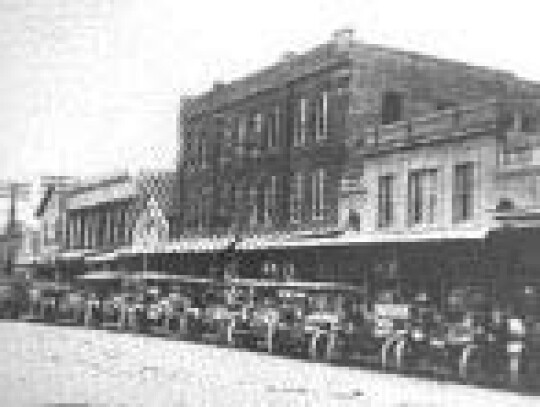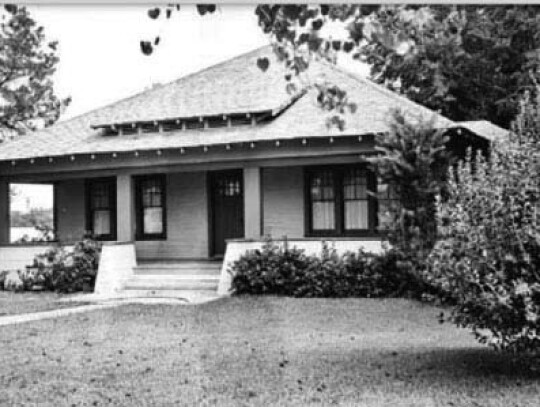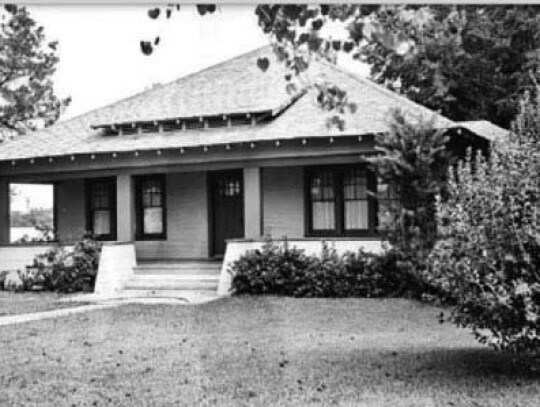Eagle Lake Remembers
Downtown Eagle Lake citizens with cars facing out assembled to meet visitors to the town and prospective land buyers as a welcome event
This home at 801 Warwick was the “Model Home” for the “Highland Park” Addition project in Eagle Lake, in 1911. Made of cypress wood, it was the former home of Helyn and Bill Farris, the Berlin Haydens, the William Waddells, and a Miller family.
It doesn’t seem so long ago. President Taft was in office. Pancho Villa was leading the Mexican Civil War, and Texas A&M was opening its studies of agriculture, research, and extension. The town was evolving. Farming was becoming more mechanized and attractive, and rice-growing was now more than an experiment, Eagle Lake’s farming opportunities and related businesses were abundant. The three local railroads were rapidly creating Eagle Lake as a shipping center. With over a third of the nation’s population in agriculture, northern eyes began to look southward. Eagle Lake seemed a promising destination.
After Chicago’s Swedish John Linderholm bought 60,000 acres of local land in the late 1800s, to encourage mid-western immigration, another Chicago man, A.E. Fox, established a local development company to attract immigrants to Eagle Lake to buy home properties in a “sub-division of the future” called “Highland Park.” A.E. Fox & Company bought the land, laid out the plots, and devised a grand development plan for the future
Eagle Lake.
Like other developers, Fox created an information catalog and a sketch, with glowing descriptions of a beautiful, fertile land around a progressive, rapidly developing town. It was true that the railroad access was a strong enticement, and that the area had enough space for a “grand development” plan likely equaling a town of 25,000.
His recruitment plan was bold and attractive. “Half-way between Houston and San Antonio,” he said, “Eagle Lake has no competitor, and land is being bought up at fancy prices.” Highland Park was planned on the north side of town, and lots were established. “The most beautiful homes will be there, and will extend far beyond the current borders.”
Fox was certain to attract visitors, as he partnered with the railroads to bring in homebuyers at no cost, if they bought. With the high school building at the entrance to Highland Park, he assured buyers of a good education for their children. Highland Park was so named because it was the highest point in town, on table land, a “good eighteen feet higher than the downtown area,” and “the most desirable property in the city.”
The A.E. Fox & Company descriptions spoke of the crystal waters of the lake to the south; the lake as a pleasure resort; the town as a beautiful little city; its location as in the most favored section of Texas, deep in the heart of the rice, cane, and cotton belt of the Gulf Coast, near the Colorado River. “Eagle Lake, for its age, has never been excelled, and has had but one equal in the line of progress and prosperity; that of Oklahoma City,” according to Fox.
With “splendid free schools, four fine church buildings, three good banks, two newspapers, water works; a fire department; an electric light plant; an ice manufacturing plant; two large rice mills; a large sugar refinery; two large lumber yards; tin and iron works; wholesale houses; bakeries; several hotels; a fine Opera House; and free open-air evening concerts in the bandstand, who wouldn’t see the opportunities for home-buying in such a reputable place?
Aside from his generous descriptions of Eagle Lake and its surroundings, E.A. Fox also made an appeal to the business side of home investing in this city, located in the “sugar bowl” of Texas. He likened home-buying in Highland Park to achieving a triple monetary return, and paying for “your child’s college education,” while living in the beauty spot of Eagle Lake.
To “calculate the cost of a few cigars a day,” would enable buyer to envision the low cost of putting $10.00 down and paying $10.00 per month to achieve ownership in Highland Park. With compelling reasons to buy, he went a step further to build a model home in Highland Park, which would further entice ‘northern buyers.’
The “Model Home” in Highland Park was completed, made of cypress wood in an attractive design of the era. It will be remembered as the familiar home of Helyn and Bill Farris at 801 Warwick, where Helyn had her flower shop for years before moving their business to the Farris Hotel downtown. Several other prior owners of the model home were the Miller family; the William Waddell family; and the Berlin Hayden family. The Highland Park area was located near the high school grounds northward to proximity of the current airport area.
While the “Highland Park” project brought a number of home-buyers, it was never completely developed. The advertising and dreams of owning homes in a progressive, Texas town continued, however, with positive effects for years. Another family with ties to A.E. Fox was the McCreary family of Eagle Lake. They had come from Alabama to San Antonio, and by marriage were linked to the Fox family. A.E. Fox had moved to San Antonio, and through family ties the McCrearys learned about Eagle Lake, and came to engage in the mercantile and mortuary business, land-owning and farming.
The “Highland Park” notion of A.E. Fox was one of many dreams, which brought new families to settle in Eagle Lake in the early 1900s. His idea of selling modern home sites began in 1910, when Fox thought of opportunities to bring others to the advantages of a growing, progressive, young Texas town. The large symbolic stone and iron entrance to “Highland Park” on the brochure no longer stands; but the memories of Eagle Lake’s “Neighborhood of the Future,” in 1911, will remain.
.jpg)





